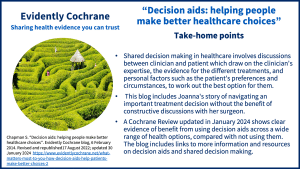When faced with healthcare choices, how do we work out what to do? Decision aids can help, as can good conversations with our clinicians as part of shared decision-making, discussions that take into account clinical expertise, evidence and personal factors such as our preferences and circumstances. This blog includes Joanna’s story of her experience of making an important treatmentSomething done with the aim of improving health or relieving suffering. For example, medicines, surgery, psychological and physical therapies, diet and exercise changes. decision but without the benefit of supportive discussions with her surgeon, plus some Cochrane evidenceCochrane Reviews are systematic reviews. In systematic reviews we search for and summarize studies that answer a specific research question (e.g. is paracetamol effective and safe for treating back pain?). The studies are identified, assessed, and summarized by using a systematic and predefined approach. They inform recommendations for healthcare and research. and useful resources.
Page originally published 6 February 2014. Revised and republished 17 August 2022 and updated 30 January 2024 with the latest Cochrane evidence.
Take-home points
When faced with choices about treatment, how do we work out what to do? We no longer just hand ourselves over to the doctor to tell us what’s best. Rather, our clinicians should help us to reach a decision – referred to as shared decision-making (or a shared understanding of medicine). The conversation should draw on the clinician’s expertise, the evidence for the different treatments, and personal factors – including treatment aims, preferences and circumstances.
Much of the time there isn’t a single ‘best’ choice. Ideally, there’s good evidence telling us how effective a treatment is and what the potential harms are, but often this is lacking. There is often a trade-off between benefits and harms, and I might view these differently from you. We need to consider our values, what is most important to us in this situation? This becomes especially crucial when we need to make a choice when there’s no clear ‘best’ treatment.
It doesn’t always go like this. Joanna was clear about what was important to her when she faced the prospect of having surgery, but she wasn’t invited to discuss this or participate in making a choice about treatment, as she explains here:
Joanna’s story
“I had a fistula – an abnormal connection between two organs. In my case, rectum and vagina. They are often hard to fix as the body is fooled into thinking they are supposed to be there so it’s not as simple as repairing a wound. Following my first failed repair the symptoms were awful – waste would travel down through the fistula and out of the wrong hole. It was suggested I have a temporary colostomy before the next repair, to alleviate the symptoms and hopefully give the next repair a better chance of working.
I did a little research before I went in for the colostomy surgery and found that there are two main types formed. A temporary colostomy is what’s often called a loop – the bowel is brought out to the surface and rather than cutting right through it, a nick is made. Imagine cutting through a hosepipe, but not all the way and bending the pipe back; you will have two holes, an upwards and a downwards. This is like a loop colostomy, and the bowel is sewn onto the skin to form the stoma. The only problem I could see with this was that waste could overflow into the downward hole and to the fistula – leaving me back where I started, with the added hassle of a colostomy bag to deal with too. The alternative stoma is called an end, where the bowel is cut right through so there is no chance of waste ending up in the wrong place. A compromise would be to make a loop stoma and suture the downward hole.
So I went into hospital feeling fairly knowledgeable after my few days of “Googling”, hopeful that the stoma would give me a break from these mortifying symptoms. It was by chance that I got to have a chat with the registrar. I was bumped from the list two days running due to emergencies and when he came to explain an urgent case earlier had knocked me off theatre list I asked if he planned a loop or end colostomy. He told me it would be a loop. Now the fresh, Google-powered, info whirled around in my mind and I asked ‘why a loop rather than an end’? I’d also spoken to a stoma nurse, who had agreed the end stoma was the sensible option, so I was a little surprised at his answer. He said it was technically easier. Yes perhaps, but what about the chance of ‘overspill’? The whole reason for the colostomy was to stop waste from going near this horrible fistula. He explained it was “such a job” to make sure the right end was brought out – imagine if it was the wrong end! I’m afraid I turned into stroppy patient and suggested perhaps they could poke something up from the bottom end and see which hole it came out of and sew up the downward hole at least. He left, conversation unfinished.
On the second day of being bumped, I asked again. I was terrified of the whole business and the thought that my symptoms may not even be helped made me question the surgery. He told me now that I had asked twice, the decision was mine to make. Hang on here, I want to make an informed choice but here you are handing it over to a quivering wreck! I just wanted someone to explain clearly the pros and cons of both approaches and to discuss the impact this may have on my personal outcomeOutcomes are measures of health (for example quality of life, pain, blood sugar levels) that can be used to assess the effectiveness and safety of a treatment or other intervention (for example a drug, surgery, or exercise). In research, the outcomes considered most important are ‘primary outcomes’ and those considered less important are ‘secondary outcomes’.. I felt that my situation was not being considered in the decision process. As it was, I had a loop colostomy, downward hole sutured, but only because I battled for it. If there had been a short conversation where the options were discussed, I think I could have been spared much anxiety and the surgeon spared the frantic, terrified, patient rant. I have met a number of people in a similar situation who have had to have further surgery to convert a stoma from a loop to an end; if they’d been given the options to begin with it may have saved them extra worry, and saved the NHS the money for an extra surgery.”

Decision aids can help
Several things could have made this a better experience for Joanna, and the use of a decision aid (sometimes called patient decision aids or PDAs) is one. These resources (which might be leaflets or videos, for example) support people in making a health decision by setting out the decision to be made, providing information on the options, including the benefits, harms and uncertainties, and helping them work out what matters most to them. They are not designed to replace consultation with a healthcare professional but to supplement that.
An important Cochrane ReviewCochrane Reviews are systematic reviews. In systematic reviews we search for and summarize studies that answer a specific research question (e.g. is paracetamol effective and safe for treating back pain?). The studies are identified, assessed, and summarized by using a systematic and predefined approach. They inform recommendations for healthcare and research. on Decision aids for people facing health treatment or screening decisions (January 2024) has just had a major update and now draws on over 200 studies, focusing on 71 different health decisions. It has clear evidence of benefits of using decision aids compared to people receiving usual care (no decision aid). Decision aids led to large increases in knowledge, a more accurate perception of riskA way of expressing the chance of an event taking place, expressed as the number of events divided by the total number of observations or people. It can be stated as ‘the chance of falling were one in four’ (1/4 = 25%). This measure is good no matter the incidence of events i.e. common or infrequent. and a more active role in decision-making. Decision aids also probably helped more adults make decisions that reflected what was important to them. There were no unwanted effects associated with using a decision aid. For a thoughtful discussion of this Cochrane Review and decision aids in practice, do read the Cochrane editorial Decision aids: challenges for practise when we have confidence in effectiveness.
Decision aids and question prompts are among the things that may be used by healthcare professionals and health support workers supporting people to actively take part in health decisions through ‘decision coaching’. The Cochrane Review Decision coaching for people making healthcare decisions (November 2021) found that decision coaching may improve people’s knowledge when used with evidence‐based information but may make little or no difference without that. It may have little or no effect on anxiety.
The number of available decision aids is growing, along with other resources to help you make informed health choices, and we have included some useful links below.
More information and resources
- The National Institute for Health and Care Excellence (NICE) has patient decision aids for a range of conditions, available from their page on Making decisions about your care. These are developed as part of NICE guidance and are reviewed as part of the surveillance process for the guidance to which they relate. If the guidance and the relevant recommendations are modified, the decision aid will also be updated.
- NICE also has a Shared decision making guideline (published June 2021)
- Choosing Wisely Shared Decision Making Resources for both patients and clinicians, including a leaflet for patients with questions that can help them make the right choices for them.
- NHS England Shared decision-making
There are many Evidently Cochrane blogs that touch on, or illustrate, decision making but here are just a few you may find useful:
- Informed decision-making: “we can” doesn’t mean “we should” contains some principles and questions that are helpful when supporting someone in making a health decision, and tells the story of helping an older relative with dementia in making a decision about treatment.
- Heavy periods: evidence to help you weigh up treatment options highlights some questions you may wish to consider and discuss with a healthcare professional and looks to a NICE decision aid. There is also a decision aid on the page Featured Review: Interventions available during pandemics for heavy menstrual bleeding: an overview of Cochrane reviews.
- In My OCD story: evidence-based medicine to the rescue! and a follow-up blog My OCD journey 2: learning and compassion in tough times Karen Morley writes about seeking help for OCD and what empowered her in shared decision-making.
- In Glioblastoma: honest conversations for shared decision-making Peter Buckle, a patient advocate whose wife died of glioblastoma, and Professor Scott Murray, GP and palliative care innovator, call for honest communication between health professionals and people with glioblastoma and their families, enabling shared decision-making and planning, with a focus on quality of life. They give sources of information and support for patients and families, and practical suggestions for clinicians.
- The blog Cataract surgery: a quick look is one of several short blogs which shows how using the BRAIN questions can help with making health choices. These are What are the Benefits, Risks, Alternatives, what do I want and what if I do Nothing?
- In Frozen shoulder: making choices about treatment I’ve talked about how I approached the treatment options.
Join in the conversation on Twitter with @SarahChapman30 @CochraneUK or post a comment here.
Please note, we cannot give specific medical advice and do not publish comments that link to individual pages requesting donations or to commercial sites, or appear to endorse commercial products. We welcome diverse views and encourage discussion but we ask that comments are respectful and reserve the right to not publish any we consider offensive. Cochrane UK does not fact check – or endorse – readers’ comments, including any treatments mentioned.
Sarah Chapman has nothing to disclose.




Reblogged this on Soumyadeep B.
Joanna’s experience of wanting, but not finding, a health professional to talk about the decision-making is likely to be quite common. Our review (1) looked at interventions to support women making a decision about mode of birth after a previous caesarean delivery, an increasingly common situation. Only one of the interventions used in the three trials included in our review involved discussion with a clinician (a research nurse, not someone involved in the actual care of the women).
Our review included both decision aids and other types of decision support. We categorised them according to a framework suggested by Glyn Elwyn and colleagues (2), where interventions are either used independently, shared with health professionals during clinical encounters, or mediated in social encounters with others. None of the interventions were judged as designed to be shared with the clinicians involved in the actual care of the women. Two trials tested decision aids and the third involved a prenatal education and support program.
We found no difference in planned mode of birth, actual mode of birth or in the proportion of women unsure about their preference. There was also no difference in the adverse outcomes reported between intervention and control groups, although these were only reported in one trial. We also found no difference in the proportion of women achieving congruence between their preferred and actual mode of birth. However, decisional conflict about preferred mode of birth was lower (they had less uncertainty) for women who received decisional support and their knowledge was higher. However the evidence for this outcome is considered to be moderate quality only. Satisfaction was no different for women with decision support and those without it. None of the studies assessed regret or whether women’s information needs were met.
We also looked at reports of qualitative data gathered in interviews with women and health professionals in one trial to make some assessment about the acceptability of the decision support and its feasibility of implementation. Women liked the decision support (a decision aid) and perceived a sense of choice and information available to them, which was typically discussed in relation to their previous birth experience. However health professionals were concerned about the impact of its use on their time and workload.
We concluded that evidence in this area is limited to independent and mediated decision supports and that research is needed on interventions that support shared decision-making between women considering mode of birth in a pregnancy after a caesarean birth and their care providers.
(1) Horey D, Kealy M, Davey MA, Small R, Crowther CA. Interventions for supporting pregnant women’s decision-making about mode of birth after a caesarean. Cochrane Database of Systematic Reviews 2013, Issue 7. Art. No.: CD010041. DOI: 10.1002/14651858.CD010041.pub2.
(2) Elwyn G, Frosch D, Volandes A, Edwards A, Montori V. Investing in deliberation: a definition and classification of decision support interventions for people facing difficult health decisions. Medical Decision Making 2010;30:701-11.
Thanks very much for taking the time to write about your review here – it’s really interesting. It would be great to hear from anyone who has used one themselves, either as a health practitioner or as a patient faced with a choice. I hope we see more high quality research in this area as it as clearly so important to know whether this type of intervention justifies the resources needed and whether it can make a difference, as it surely has the potential to do.
Sarah Chapman